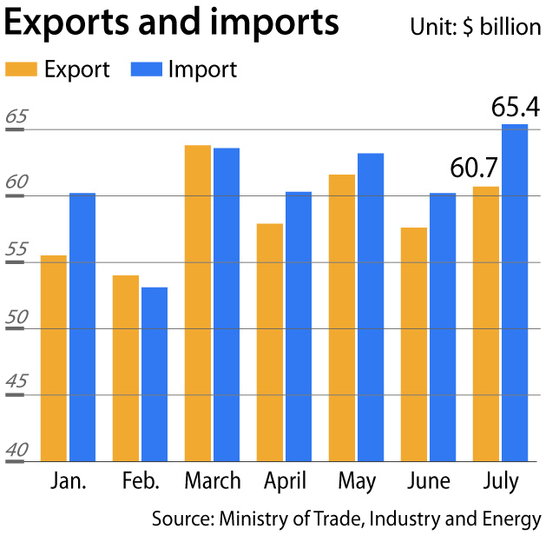Korea reports fourth consecutive monthly trade deficit
![A port in Busan on Monday. Korea’s trade deficit continued for a fourth straight month as higher energy prices and a weak won led to a rise in imports. [YONHAP]](https://koreajoongangdaily.joins.com/data/photo/2022/08/01/029b6572-13d3-4664-94b2-10418bcea68b.jpg)
A port in Busan on Monday. Korea’s trade deficit continued for a fourth straight month as higher energy prices and a weak won led to a rise in imports. [YONHAP]
It was the fourth monthly trade deficit in a row, the first time that has happened in 14 years.
In July, imports rose 21.8 percent year-on-year to $65.4 billion, while exports increased 9.4 percent to $60.7 billion, according to the Ministry of Trade, Industry and Energy on Monday.
Imports have been exceeding $60 billion for five consecutive months and outpacing export growth.
Exports have been growing for 21 consecutive months. In the first seven months of the year, accumulated exports totaled $411.2 billion, which is a new record for that period.
The trade deficit in the first seven months totals $15 billion. Korea's trade deficit with China has continued for three consecutive months. Aug. 24 marks the 30th anniversary of the establishment of diplomatic relations between the two countries.
Korea sent 23.2 percent of its exports to China in the first half.
"The fact that exports grew for the 21st consecutive month despite slowing global economic growth as a result of major countries rolling back policies is a positive sign," said Minister Lee Chang-yang. "However, due to high energy prices and summer energy demand, we have recorded a trade deficit for the fourth month.
"The slowing export growth — since June in the single digits — and a growing trade deficit due to the slowing global economy, including China's, is a major concern."

In the first seven months of the year, energy imports surged 499.1 percent to a total of $106.4 billion.
The price of Dubai crude in July slightly dropped from the previous month to $103.14 per barrel. In January, it was $83.47.
The weakened Korean currency exacerbated the problems.
Despite the unfavorable situation, the government stressed the robust exports.
Exports of semiconductors grew 2.1 percent to $11.2 billion in July.
Semiconductor exports have been increasing year-on-year for 25 consecutive months. For 15 months, the total has exceeded $10 billion.
According to the government, while the prices of DRAM and NAND memory have been falling, demand from China and Asean remain strong.
Semiconductor exports to China last month grew 10.9 percent year-on-year, while exports to Asean markets grew 45.3 percent.
In July, petroleum goods exports surged 86.5 percent to $6.7 billion, a new record.
Exports of Korean automobiles grew 25.3 percent year-on-year to $5.1 billion. This is the first time that Korean automobile exports exceeded $5 billion.
The previous record was $4.7 billion in December 2014. The increase in Korean automobile exports was largely a result of demand recovering as the supply of chips is returning.
Exports of rechargeable batteries increased 11.8 percent year-on-year to $880 million.
By country, exports to China in July fell 2.5 percent to $13.2 billion. The biggest cause was the slowing economy in China. The Chinese economy in the second quarter grew 0.4 percent year-on-year, the slowest growth in two years and a sharp drop from a 4.8 percent growth in the first quarter.
Exports to U.S. grew 14.6 percent year-on-year to $10 billion, a record. The previous monthly record was set in June this year at $9.8 billion.
Exports to U.S. have been increasing for 23 consecutive months.
According to the ministry, despite the U.S. Federal Reserve increasing interest rates to combat inflation, sales of electric vehicles have increased, which helped boost Korean automobile and rechargeable battery exports.
Exports to the EU grew 14.6 percent year-on-year to $6.1 billion and to Asean grew 20.9 percent to $11.7 billion.
Exports to India surged 92.4 percent to $2.4 billion, and exports to the Middle East were up 11.7 percent to $1.5 billion.
In recent years, the Korean government has been diversifying export markets in an effort to hedge risks stemming from the heavy reliance on specific markets. Such efforts included joining the 15-member Regional Comprehensive Economic Partnership.
According to the government, Korea's exports to Asean markets and India have been increasing for 17 straight months.
BY LEE HO-JEONG [lee.hojeong@joongang.co.kr]










with the Korea JoongAng Daily
To write comments, please log in to one of the accounts.
Standards Board Policy (0/250자)